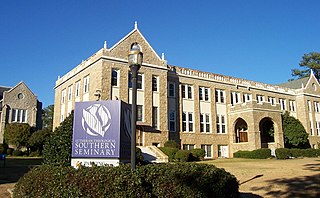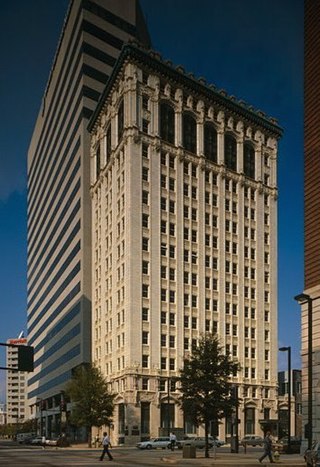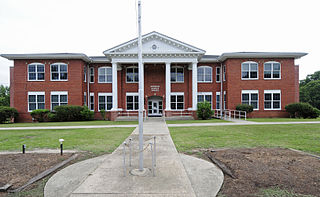
Logan Circle is a historic roundabout park and neighborhood of Washington, D.C., located in Northwest D.C. The majority of Logan Circle is primarily residential, except for the highly-commercialized 14th Street corridor that passes through the western part of the neighborhood. In the 21st century, Logan Circle has been the focus of urban redevelopment and become one of Washington's most expensive neighborhoods. Today, Logan Circle is also one of D.C.'s most prominent gay neighborhoods.

The South Carolina State Museum is a museum dedicated to the history of South Carolina. It has four floors of permanent and changing exhibits, a digital dome planetarium, 4D interactive theater, and an observatory. The State Museum is located along the banks of the Congaree River in downtown Columbia, South Carolina. It is the largest museum in the state, and is a Smithsonian Affiliate and part of the American Alliance of Museums. Positioned on an old shipping canal that dates back to pre-Civil War times, the museum is widely recognized as a resource for South Carolina history and lifestyle. The museum opened on October 29, 1988, and is housed in what it calls its largest artifact the former Columbia Mills Building, listed on the National Register of Historic Places in 1982. When the mill opened in 1894, manufacturing cotton duck cloth, it was the first completely electric textile mill in the world. It was also the first major industrial installation for the General Electric corporation. On certain levels of the museum, the original flooring has been kept intact, distinguishable by the textile brads and rings that became embedded in the floor while it was still being used as a mill. The South Carolina Confederate Relic Room & Military Museum is located within the Columbia Mills Building and is the oldest museum exhibit in Columbia.

Mary H. Wright Elementary School is a former school building in Spartanburg, South Carolina. It was constructed in 1951 as part of SC Governor James F. Byrnes's attempt to establish "separate but equal" facilities in order to avoid desegregation of schools. After integration, it continued to serve as an elementary school until 2001, when a new school of the same name was constructed nearby. The building served as a learning center and then a housing authority office over the next several years until it was left vacant in 2016. In 2022, it was renovated into Schoolhouse Lofts, a 53-unit apartment development.

The Old Campus District, University of South Carolina, is a historic district centered on The Horseshoe on the main campus of the University of South Carolina in Columbia, South Carolina. On June 5, 1970, it was listed in the National Register of Historic Places. On April 19, 1996 MTV Unplugged filmed Hootie & the Blowfish's concert on The Horseshoe before the release of their second album Fairweather Johnson.

Elmwood Park is a residential neighborhood and historic district in what is now the center of Columbia, South Carolina. Founded in the early 1900s, it was added to the National Register of Historic Places as Elmwood Park Historic District in 1991.

The McMaster School, built in 1911, is an historic building located at 1106 Pickens Street on the corner of Senate Street in Columbia, South Carolina. It was designed by noted Columbia architect William Augustus Edwards of the firm of Edwards and Walter. Edwards and his partner, Frank C. Walter, designed sixteen schools according to standardized guidelines established by the state legislature in 1905. The architects chose a Renaissance Revival style with H-shaped floor plans used as the standard for the state in buildings designed and constructed by other architects. The State newspaper declared it the "handsomest school building in Columbia" when it opened in 1911.

The Walhalla Graded School, built in 1901, is an historic building located at 101 E. North Broad Street in Walhalla, South Carolina. It was designed by noted Columbia architect William Augustus Edwards of the firm of Edwards and Walter and built by Grandy & Jordan of Greenville.

The Hampton–Preston House located at 1615 Blanding Street in Columbia, South Carolina, is a historic mansion that was the home of members of the prominent Hampton family. It was listed in the National Register of Historic Places on July 29, 1969.

Burroughs School, also known as Burroughs Graded School, is a historic school located at Conway in Horry County, South Carolina. It was built in three phases between 1905 and 1923. The earliest portion of the building was built as an elementary school and has three main portions of eleven bays. It features a one-story, hip roof porch supported by six Ionic order columns with Scamozzi capitals. About 1915 a two-story hipped classroom wing was added and in 1923 four classrooms and an auditorium was added to the complex.

Ebenezer Lutheran Chapel is a historic Lutheran chapel located in Columbia, South Carolina. It was built in 1830, and rebuilt in 1870, while the restoration took place in 1993 and is a brick church that was extensively renovated in 1900. The front façade features two square towers and finely detailed art glass windows. Adjacent to the church is a Lutheran cemetery which dates to the early 1800s.

Ladson Presbyterian Church is a historic African American Presbyterian church located at 1720 Sumter Street in Columbia, South Carolina. The religious building was initially a chapel founded in 1838 and, rebuilt in 1896, and is a one-story-over-raised-basement, rectangular red brick building in the Renaissance Revival style. It has a front gable roof and features two brick entrance towers. The congregation was founded in 1838, as an offshoot congregation of the First Presbyterian Church.

Beam Dormitory was the first permanent building at the American Lutheran Theological Southern Seminary in Columbia, South Carolina. It was built on the highest point in Columbia in 1911 based on a design by noted Virginia architect Charles M. Robinson. The structure was built by Wise Granite Co. It included a chapel, housing, refectory, classrooms, and faculty offices. Beam Hall is now used as a dormitory and also contains office suites, meeting rooms, and an exercise facility. The building was listed on the National Register of Historic Places in 1979.

Edward Culliatt Jones was an American architect from Charleston, South Carolina. A number of his works are listed on the U.S. National Register of Historic Places, and two are further designated as U.S. National Historic Landmarks. His works include the following :

The Palmetto Building, built during 1912–1913, is an early skyscraper in Columbia, South Carolina. It was designed by architect Julius Harder, and Wilson and Sompayrac served as supervising architects. Upon completion it was the tallest building in South Carolina at 215 ft (66 m) and with 15 floors.
Woodruff High School is a public secondary school in Woodruff, South Carolina, United States, and is the only high school in Spartanburg County School District 4.

The James Logan Elementary School is an historic American elementary school building that is located in the Logan neighborhood of Philadelphia, Pennsylvania.

Warrenville Elementary School, originally known as Warrenville Graded School, was constructed in 1925 and used to educate mill village children located in and around the Warrenville, South Carolina area. In 1954, two wings were added to the building. This Aiken County, South Carolina school was listed on the National Register of Historic Places on May 22, 2002.

Old Batesburg Grade School, also known as Batesburg Elementary School, is a historic elementary school building located at Batesburg-Leesville, Lexington County, South Carolina. It was built about 1912, and is a two-story, brick Neo-Classical school building with a central tetrastyle portico and flanking pavilions. The central portico has four colossal Tuscan order columns. An auditorium is located at the rear of the building. Wing additions were added about 1945. It was the town's first public school, housing grades 1–11.

Florence C. Benson Elementary School, also known as Wheeler Hill School and the Benson Building, is a historic school building for African-American students located at Columbia, South Carolina. It was built in 1953–1955 in Wheeler Hill, a segregated African-American neighborhood, as an "equalization school." The one-story, three-finger plan school, is built of concrete block with a red brick veneer and reflects influences of the Modern and International styles. The school housed 18 classrooms. The school closed in 1975.

Horry-Guignard House is a historic home located at Columbia, South Carolina. It was built before 1813, and is a two-story, late Federal style, modified I-house type frame dwelling. The front facade features a one-story, full-width balustraded porch supported by square columns. During the winter of 1813–1814, the main hall was widened from six feet to eleven feet. To do this, the house was sawed in half and the two ends were pulled apart to rest on two new foundations. It was probably built by Peter Horry (1747-1815), a Revolutionary War Colonel and Brigadier General of the South Carolina Militia. Later, the house was acquired by John Gabriel Guignard (1751-1822), the Surveyor General of South Carolina from 1798 to 1802. Guignard is responsible for the early design of the city and laid out the first streets of Columbia.
























